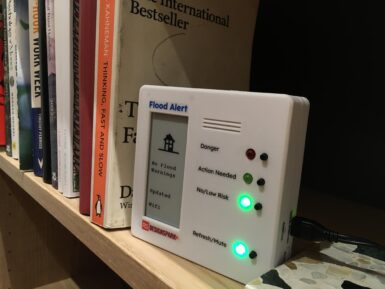
NFC/RFID reader with two transponders
NFC/RFID reader/writer with 1 status LED, antenna integrated on PCB, I²C, SPI, and HSU (High Speed UART) communication interface
Overview
It can function as an RFID card reader/writer, NFC reader with Android smartphone and in wireless mode with two identical devices.
It can be used with Arduino to create access control devices.
The package includes the reader, a keychain transponder, a card transponder and connection cables.
Tech specs
- Power supply: from 3.3 V to 5 V
- Compact and easy to integrate into your project
- Supports interface: I²C, SPI and HSU (High Speed UART), selectable via dip-switch
- Supports RFID read/write, P2P communication between two identical modules, NFC with Android smartphone
- Supports RFID read/write:
- Mifare 1k, 4k, Ultralight, and DesFire cards
- ISO/IEC 14443-4 cards such as CD97BX, CD light, Desfire, P5CN072 (SMX)
- Innovision Jewel cards such as IRT5001 card
- FeliCa cards such as RCS_860 and RCS_854 - Reading distance (mm): max. 50-70
- Dimensions (mm): 43x41x4
Conformities
Get Inspired
An IoT Moisture sensor that sends moisture data from an Arduino Nano 33 IoT to the Arduino IoT Cloud

As climate change continues to worsen, events such as heavy rains, hurricanes, and atmospheric rivers have only intensified, and with them, large amounts of flooding that pose serious risks to life and property. Jude Pullen and Pete Milne, therefore, have responded by creating a "physical app" that can show the potential for flood dangers in real-time with sound, lights, and an ePaper display. The Arduino Nano 33 IoT powering the Flood Alert device sources its data from the UK Environmental Agency’s API to get statistics on an area’s latest risk level along with an extended description of what to expect. Initially, the electronics were mounted to a breadboard and housed within a cardboard enclosure, but a later revision moved everything to soldered protoboard, a 3D-printed case, and even added a piezoelectric buzzer to generate audible alerts. For now, the Flood Alert’s sole source of data is the aforementioned API, but Pullen hopes to expand his potential data sources to include “hyper-local” sensors that can all be aggregated and analyzed to give a much more precise view of flooding in a smaller area. To learn more about Flood Alert and its myriad applications to local communities and beyond, check out the original long read article’ is available at DesignSpark.








